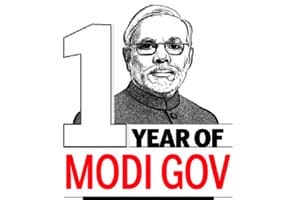The first anniversary of one of India’s most momentous elections has been a natural occasion for taking stock of what has been accomplished over the past year. It has also been natural to focus on the prime minister as the driver of change or lack of it: No one has dominated the Indian political scene like he does, since the days of Indira Gandhi or Jawaharlal Nehru. There are so many areas where one can note some progress, or find its absence, that one has to try to pick the most important indicators of what has changed and what has not. I will do that here, after noting some obvious trends. On the economic front, financial sector reform and tax reform continue to make slow headway—they have actually been happening for over two decades, so the last year is nothing special. The struggle over land acquisition and labour laws also seems to be a difficult and complicated process. These are not significantly new trends, and there are no momentous new achievements. The creeping Hindutva of the past year is also not surprising, though its cumulative effects as it continues will be felt more sharply in coming years.
What does stand out in the last year? I think the focus on reform and revitalization of the railways is something that has not been seen since the colonial era. It is true that here, too, the intellectual effort began under the previous regime, but the PM’s attention, and choice of a competent minister to lead the reform charge, are extremely promising. Vigorous investment in the railways, along with institutional reform, could be one of the most important contributors to India’s economic development since Independence. Of course the changes are still to come, but the prioritisation and focus seem to be there. If anything, the power sector could benefit from a similar approach—this is the other area of infrastructure deficiency that has enormous and pervasive negative implications for economic growth.
A second standout achievement of the last year has been the PM’s trips to a wide range of countries, including China, Japan, South Korea, France, Germany, Canada and the United States. The significance of these visits is not just a new positioning of India’s foreign policy strategy, but the beginning of vigorous attempts to attract foreign technology and investment. How well that happens may well be the most important determinant of India’s future economic growth. Investment from these countries and others will help integrate India into global production chains, upgrade the country’s manufacturing capabilities, and even help in skilling its workforce, if foreign companies train the workers they will need. Without this investment, Make-in-India will not succeed. A huge effort will be needed to smooth the way for such investment, and competition among companies from different countries has to be encouraged, making speed and scale critical factors. It may be that the process will be driven at the state-level, but the Centre will have to make sure there are no roadblocks. Bureaucrats at all levels have to be able to manage and smooth this process.
The Smart Cities initiative may be a way to complement and facilitate such foreign direct investment. So far, the rhetoric does not seem to be well anchored in reality, but bringing in foreign investment for new urban infrastructure may be a feasible path for actually accomplishing something. A big push here may catalyse some innovations in financial markets that would have positive spillovers for other infrastructure financing. The plan for more low-cost housing (“for all,” according to the official goal) is also an obvious complement to the projected urban transformation. Perhaps the only things missing are a focus on property tax reform, and bureaucratic capacity at the municipal level—both of which will also be needed. Smart Cities may also provide case-by-case opportunities to experiment with land acquisition processes, without getting into ideological battles at the national level.
Lack of management capacity will be the hardest obstacle to overcome, in implementing these kinds of major initiatives. In this context, the lack of attention to rapid reform, expansion and opening up of higher education to foreign collaboration may be the weak spot in a policy cluster that is reminiscent of the East Asian model of, to use Robert Wade’s description, “governing the market” for economic development. The bureaucracy may also be stretched too thin, both in people and knowledge, to manage the kind of transformation that is envisaged and necessary. In some ways, this is the fundamental problem of economic development, a scarcity of human capital. How well this scarcity is overcome will determine whether the new prime minister’s vision of economic development can be turned into reality. This is one area where it is not clear whether the PM realises the scale of the need for project selection and management expertise.
In sum, a year of Modi has seen a strong vision of economic development, inspired by East Asia’s example, articulated but not yet implemented. This has been overlaid on a gradual reform process that has been puttering along for over two decades. Perhaps another year’s passage will provide clarity on the chances of long-run success.
The author is Professor of Economics, University of California, Santa Cruz
For Updates Check Editorials and Columns; follow us on Facebook and Twitter


